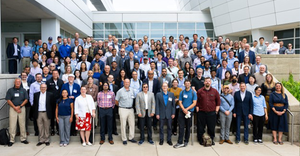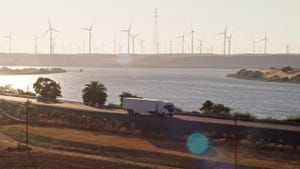Enbridge Blazes RNG Pathway
Energy delivery company Enbridge is having a healthy growth spurt on the renewable natural gas (RNG) front. The Calgary, Alberta-based corporation recently purchased seven operational landfill methane-to-RNG facilities in the U.S. and broke ground on an anaerobic digestion (AD) plant to make RNG in Longview, Washington.
November 29, 2023

Energy delivery company Enbridge is having a healthy growth spurt on the renewable natural gas (RNG) front. The Calgary, Alberta-based corporation recently purchased seven operational landfill methane-to-RNG facilities in the U.S. and broke ground on an anaerobic digestion (AD) plant to make RNG in Longview, Washington. Alongside these transactions Enbridge is closing on three projects under its Canadian utility business, Enbridge Gas, adding to this division’s six existing facilities, with 50 more in development.
Reportedly the largest energy company in Canada, Enbridge Gas is set to expand further, with the purchase of three U.S. utilities owned by Dominion. The acquisition will bump its retail customer base from four million to seven million and significantly increase the 1.45 billion cubic feet (BCF) of RNG it currently produces each year.
The seven facilities, purchased from Morrow Renewables, will be Enbridge’s first landfill gas-to-RNG venture in the U.S., with the transaction expected to close in early 2024.
Why look to the States?
“Enbridge transports about 20% of natural gas in the U.S. over 25,000 miles of pipeline, so we are looking for opportunistic projects along our system. It’s also adjacent. We are in the natural gas business, so if we can move natural gas cleaner, we are interested,” says Caitlin Tessin, Enbridge’s vice president of Strategy and Market Innovation.
Still, the company keeps an eye out for prospects wherever there’s supportive policies and incentives. That said, the Inflation Reduction Act (IRA) investment tax credits made the U.S. all the more appealing, Tessin says.
Landfill-gas-to energy projects like the seven Morrow facilities are gaining traction among disposal site operators who generate revenue from the methane they would otherwise flare that’s now converted to transportation fuel, and sometimes power or heat.
Collectively the seven newly acquired assets—six in Texas and one in Arkansas –produce about 5 billion BCF of RNG per year, which Enbridge expects will surpass 8 BCF by 2040.
“The Morrow acquisition fits nicely with our low-risk approach to doing business. These assets are already in operation. They are located in regions with growing demographics that support ongoing landfill growth and have strong partnerships with local municipalities. And they have long-term contracts in place with credit-worthy customers,” Tessin says.
GHD evaluates the performance of existing RNG systems, focusing on commercial outcomes to ensure that the business case is viable, and vetting for potential risks.
This infrastructure is designed to last for decades, and it’s important to match the equipment with the renewable resource that the landfill can generate over time, as that resource will change, says Tej Gidda, vice president and global leader – Future Energy, GHD.
Is the facility well-suited to convert that landfill gas to renewable energy today? Will it be up to par 10 years from now? Twenty years from now?
Gidda’s team evaluated Enbridge’s new U.S. assets and ultimately checked all the boxes.
“We learned that these facilities were well-designed, well-operated, matched very well to the landfill resource, and were operating in compliance with environmental regulations,” Gidda says.
He points to another key consideration: handover of the operations and handling of the transition.
“This is going well for Enbridge. And that’s important as with a good handover, there is ample opportunity for further investments in these assets, to generate even more RNG and greater environmental benefits over time.”
Enbridge’s Longview, Washington AD project will rely on a different feedstock: food waste that technology company Divert collects from large grocery chains, including Kroger, Target, Safeway, and Albertsons. Longview, slated to launch by the end of 2024, is the first part of a billion-dollar infrastructure agreement between Enbridge and Divert, which will involve expansion across North America.
bp has signed on as offtaker for the Divert project, and both bp and Shell will purchase RNG generated through the Morrow renewable deal.
“They have been long-time customers of our traditional natural gas business, so it’s a natural extension to work with them in the RNG space. We already have that strong customer relationship, and they want the supply,” Tessin says.
While still a relatively small fish in the renewables pond, RNG is climbing the ranks.
In North America the industry eclipsed 300 operational facilities in 2023—up from a scant 30 or so in 2011.
About 178 more facilities are under construction with another 303 in planning stages, estimates RNG Coalition.
While the farm and agriculture sector have driven much of the boom lately, the municipal solid waste sector provides the lion's share.
Increasingly landfill gas rights owners are exploring RNG transportation pathways in particular, incentivized by both the federal Renewable Fuel Standard and state-level Low-Carbon Fuel Standard programs. This shift is contributing to the rapid decarbonization of hard-to-decarbonize transport, with RNG accounting for around 97% of all fuel used in natural gas vehicles in California last year, says Dylan Chase, public relations manager for RNG Coalition.
A coinciding trend is that more international players are expanding within their home countries while taking root in North America.
Australian-based EDL sparks some recent activity in partnership with Republic Services, NW Natural Renewables and Pennant Midstream; France-based Waga in partnership with a municipal waste authority in Pennsylvania; and German EnviTec Biogas who is currently developing multiple projects across the U.S.
Other international players are building out platforms in North America from as far as Sweden, Italy, Brazil, Switzerland, and Japan.
“We expect global RNG/biomethane developers from across the world will continue enhancing competition here in North America for years, due in part to unique expertise gained from the roll-out of renewable gas in their respective countries,” Chase says. Though he believes Europe’s aim to produce 35 billion cubic meters of biomethane by 2030 will further drive the region’s energy transition.
Looking to Enbridge’s future Tessin says The Morrow Renewables acquisition, combined with existing RNG projects, ideally positions the company to play in this space and take advantage of growing demand for RNG.
“We don’t have a set target in mind in terms of how big our RNG portfolio might get, but we’re excited by its future, and we like how we’re positioned.”
You May Also Like


